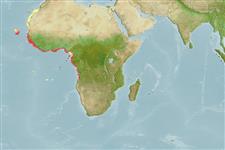Environment: milieu / climate zone / depth range / distribution range
Ecologie
marien demersaal; diepte 20 - 300 m (Ref. 127989). Tropical; 33°N - 13°S, 27°W - 15°E (Ref. 5222)
Eastern Atlantic: Western Sahara to Angola, including Cape Verde and the Sao Tome and Principe islands. Also recorded from the Mediterranean.
Lengte bij maturiteit / Grootte / Gewicht / Leeftijd
Maturity: Lm 18.0 range ? - ? cm
Max length : 70.0 cm TL mannelijk / geslacht onbekend; (Ref. 27000); common length : 40.0 cm TL mannelijk / geslacht onbekend; (Ref. 26999)
Korte beschrijving
Determinatiesleutels | Morfologie | Morfometrie
Dorsale stekels (totaal) : 9; Dorsale zachte stralen (totaal) : 15 - 16; Anale stekels: 3; Anale zachte stralen: 9 - 10. Distinguished by the following characteristics: body depth less than head length, 2.8-3.2 in SL; head length 2.7-3.0 in SL; interorbital area convex; rounded preopercle, finely serrate, with shallow notch, fleshy lower edge; subopercle and interopercle with few small serrae covered by skin; maxilla reaching vertical at rear edge of eye or beyond; pectoral fins longer than pelvic fins, pectoral fin length contained 1.5-1.7 in HL; pelvic fins reaching or nearly reaching anus; caudal fin rounded; lateral-body scales ctenoid, without auxiliary scales (Ref. 089707).
Found on sandy and rocky bottoms (Refs. 32181, 127989). Diandric protogynous hermaphrodite (Ref. 089707).
Levenscyclus en paargedrag
Maturiteit | Voortplanting | Paaien | Eieren | Fecunditeit | Larven
Pelagic spawner (Ref. 32181). Low ratio of males in population correlated with polygamy (Ref. 32181). This study (Ref. 32181), concluded that some males of C. taeniops may not pass through a functional female stage as observed in most groupers, and that these males may have developed directly from immature females conferring with the hypothesis of Shapiro (1987). Diandric (Ref. 103751).
Heemstra, P.C. and J.E. Randall, 1993. FAO Species Catalogue. Vol. 16. Groupers of the world (family Serranidae, subfamily Epinephelinae). An annotated and illustrated catalogue of the grouper, rockcod, hind, coral grouper and lyretail species known to date. Rome: FAO. FAO Fish. Synop. 125(16):382 p. (Ref. 5222)
Status op de Rode Lijst van het IUCN (Ref. 130435: Version 2024-2)
Gevaar voor de mens
Harmless
Gebruik door de mens
Visserij: van minder commercieel belang
Tools
Speciale rapporten
Download XML
Internetbronnen
Estimates based on models
Preferred temperature (Ref.
123201): 15.8 - 20.7, mean 19.2 °C (based on 47 cells).
Fylogenetische diversiteitsindex (Ref.
82804): PD
50 = 0.5000 [Uniqueness, from 0.5 = low to 2.0 = high].
Bayesian length-weight: a=0.01000 (0.00663 - 0.01507), b=3.10 (2.98 - 3.22), in cm total length, based on LWR estimates for this species & Genus-body shape (Ref.
93245).
Trofisch niveau (Ref.
69278): 4.5 ±0.80 se; based on food items.
Generation time: 8.1 ( na - na) years. Estimated as median ln(3)/K based on 2
growth studies.
Weerstandsvermogen (Ref.
120179): laag, minimale populatieverdubbelingstijd 4,5-14 jaar (Preliminary K or Fecundity.).
Fishing Vulnerability (Ref.
59153): High vulnerability (56 of 100).
Nutrients (Ref.
124155): Calcium = 82.6 [45.8, 179.5] mg/100g; Iron = 0.778 [0.383, 1.684] mg/100g; Protein = 17.9 [16.1, 19.6] %; Omega3 = 0.273 [0.144, 0.501] g/100g; Selenium = 83.4 [38.1, 179.9] μg/100g; VitaminA = 22.7 [7.7, 77.2] μg/100g; Zinc = 0.732 [0.466, 1.255] mg/100g (wet weight);
